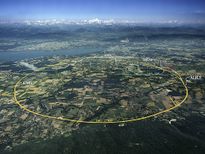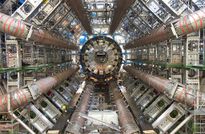Large Hadron Collider
 From Conservapedia
From Conservapedia The Large Hadron Collider (LHC) is a particle accelerator, with a circumference of 27 km, located at the CERN facility which straddles the border of France and Switzerland.[1] Built over 15 years at a cost of $9 billion, it is the largest and most ambitious piece of machinery ever conceived and built by man.
Design[edit]
The LHC has four giant detectors (named ATLAS, CMS, LHCb and ALICE) designed to probe new dimensions, search for the Higgs Boson (the so-called "God Particle", which gives matter and other bosons mass) and hypothetically to investigate what the universe might have been like immediately after the Big Bang (assuming it actually happened).
The collider was built to accelerate protons to energies of 14 trillion electron volts[2] and smash them together in search of particles and forces that reigned earlier than the first trillionth of a second of time, but the machine could run as low as four trillion electron volts for its first year. Upgrades are scheduled already.
The LHC was powered up on 10 September 2008, with the first beams being circulated through the collider. It reached full power in mid-November 2008, which is when scientists were supposed to begin smashing particles into each other. This was hampered however as the LHC suffered a mechanical breakdown just as it was switched on and it was not active again until early 2010. Numerous major problems have emerged and it may take years before the machine is fully operational.[3]
In early 2013, the machine was shut down so maintenance could be performed and it could be upgraded to run at 13 TeV.[2] This marked the end of 'Run 1'. In 2015, the machine was started again for 'Run 2' at 13 TeV. Run 2 ended in October 2018 for another long shutdown. The LHC isn't expected to restart until spring 2021.[4]
Challenges[edit]
The LHC survived legal and political challenges. Legal challenges revolve around the possibility it could open a microscopic black hole that would swallow the Earth. However scientists have effectively ruled out this scenario, pointing out - among other things - that such particle collisions take place quite often naturally.[5][6] The LHC seeks to prove or disprove other important concepts and theories, such as supersymmetry, matter-antimatter asymmetry and strong gravity.[7][8]
Ethical challenges have been raised as well, with many[Who says?] considering the search for the so-called "God particle" to be a sign of human hubris. An analogy can be made to the Biblical tower of Babel.
Discoveries[edit]
The Higgs boson was detected independently by the ATLAS and CMS experiments at the LHC in 2012.
References[edit]
- ↑ The Large Hadron Collider. Retrieved on 2018-12-20.
- ↑ 2.0 2.1 Restarting the LHC: Why 13 Tev?. Retrieved on 2019-12-20.
- ↑ See "Giant Particle Collider Fizzles," Dennis Overbye New York Times Aug. 3, 2009
- ↑ LHC Report: The final days of Run 2. Retrieved on 2012-12-20.
- ↑ Steven B. Giddings, Michelangelo M. Mangano: "Astrophysical implications of hypothetical stable TeV-scale black holes"
- ↑ Benjamin Koch, Marcus Bleicher, Horst Stoecker: "Exclusion of black hole disaster scenarios at the LHC"
- ↑ Philosophising physics. Retrieved on 2018-12-20.
- ↑ The matter-antimatter asymmetry problem. Retrieved on 2018-12-20.
External links[edit]
- LHC Homepage at CERN.
Categories: [Physics] [Particle Physics]
↧ Download as ZWI file | Last modified: 02/18/2023 03:48:44 | 5 views
☰ Source: https://www.conservapedia.com/Large_Hadron_Collider | License: CC BY-SA 3.0
 ZWI signed:
ZWI signed:

 KSF
KSF